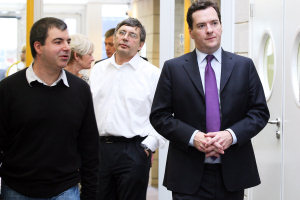New investment aims to establish the UK as a global graphene research hub
02 Feb 2012
Today sees the announcement of full details of how an additional £50 million will be spent to keep the UK at the forefront of research into ‘wonder material’ graphene. Also below are details of further investment strands for graphene engineering and research technology.

200 times stronger than steel and just one atom thick, graphene is the strongest and thinnest material ever measured, and also the world’s most conductive material. It has a wide range of potential uses, including electronics, flexible touch screens, sensors and in composite materials.
The investment will help establish the UK as a graphene research and technology ‘hub’, funded through the Engineering and Physical Sciences Research Council (EPSRC) and the Technology Strategy Board (TSB), that will lead to the rapid commercialisation of graphene technologies in the UK. There will be four investment strands, building on the strong, and rapidly-expanding, UK research in this field.
Minister for Universities and Science, David Willetts, said: "This significant investment in graphene will drive growth and innovation, create high-tech jobs and keep the UK at the very forefront of this rapidly evolving area of science. With a Nobel Prize and hundreds of published papers under their belts, scientists in the UK have already demonstrated that we have real strengths in this area. The graphene hub will build on this by taking this research through to commercial success."
A key element of the graphene hub will be a national institute of graphene research and commercialisation activities. The University of Manchester has been confirmed as the single supplier invited to submit a proposal for funding a new £45 million national institute, £38 million of which will be provided by the UK Government. This world-class shared facility for graphene research and commercialisation activities will be accessible by both researchers and business.
The national institute, funded through the Engineering and Physical Sciences Research Council (EPSRC) and The University of Manchester, will offer access to specialist facilities and equipment which enable the simulation of manufacturing processes. The University of Manchester is an acknowledged research leader in graphene research with tens of thousands of citations for graphene papers, and is the academic home Nobel Laureates, and now Knights Bachelors, Professor Sir Andre Geim and Professor Sir Kostya Novoselov, who received the Nobel Prize in Physics in 2010 for demonstrating the remarkable properties of graphene.
Professor Andre Geim said: “Creating a National Graphene institute here at The University of Manchester would allow our world-class scientists and researchers to further explore the limitless potential of graphene.
“To have such a facility here is a testament to the expertise at the University and will offer fantastic opportunities for Manchester researchers to work closely with industry and business.”
EPSRC Chief Executive, Professor David Delpy, said: “From the first grant of just over £500,000 in August 2001 which led to the demonstration of graphene, to a grant of more than £5 million awarded in October 2009 to investigate the potential of the material, EPSRC directly funded the research which led to the 2010 Nobel Prize for Physics being awarded to Professor Andre Geim and Professor Kostya Novoselov. This new investment will help accelerate commercialisation and open up new opportunities for growth.
“The applications for commercial use of graphene are vast including the creation of new materials and the manufacture of innovative electronics. The £50 million in additional funding is an important step in ensuring we can reap the benefits of those applications.
“The race to be the first country to produce commercial products is well and truly on. “
Iain Gray, Chief Executive of the Technology Strategy Board, said: “Technology innovation – and, in particular, the commercialisation and exploitation of innovation – is absolutely vital for the UK’s economic future, and to improve our quality of life. Establishing this Institute of Graphene Research will help to ensure that we capitalise on the UK’s great strength in graphene research by supporting the development of applications for the technology. This will drive economic growth and create high-tech jobs.”
Secondly, £12 million is available from the UK Government to invest in research equipment related to graphene. EPSRC will seek to fund equipment that can be used across a variety of disciplines and research groups and which will be accessible to business.
Thirdly, additional £10 million of investment is available from EPSRC’s research budget to support graphene engineering research, and accelerate the generation of novel devices, technologies and systems. It will also strengthen the UK position in relation to European initiatives with potential for further financial leverage.
Fourthly, an innovation centre to focus on the market development and exploitation of emerging graphene technologies will be established, with around £10 million of investment from the EPSRC and the Technology Strategy Board. Separate from the institute of graphene research and supported by business, the centre will help to accelerate the development, application and exploitation of new graphene technologies, in order for them to realise their full commercial and economic potential.
Professor Sir Peter Knight, President of the Institute of Physics, said: “We welcome the Government’s commitment to additional investment in the science base. Graphene is a great success story for British science and an outstanding example of the value achievable from the application of physics.”
